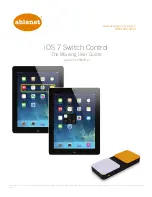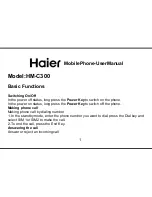
3. TECHNICAL BRIEF
- 38 -
3.2.2 Block Description
GAM Controller(GAMCON)
The GAM Controller (GAMCON) is responsible for clock gating and distribution within the GAM
module. GAMCON receives the HCLK from SYSCON and distributes to GRAPHCON, GRAM, PDI and
CDI. GAMCON also distributes the GAM reset signal to GRAPHCON, GRAM, PDI and CDI. The reset
signals CIRES_N and PDIRES_N are distributed from GAMCON to the camera and display module
respectively, see Figure. The CIPCLK is used to clock the received data into the camera data
interface. The CIPCLK can be in the range of 100 kHz to 16 MHz.
Graphics RAM (GRAM) Block
GAM includes 160 kB of graphics memory (GRAM) in order to support display screen sizes of QCIF +
alfa display size and three frame buffers when decoding QCIF video.
The GRAM can be accessed in 8, 16 or 32-bit mode. Write access takes a single AHB clock cycle.
Non-sequential read and the first access of a sequential read access takes two AHB clock cycles.
Subsequent sequential read access take a single AHB clock cycle.
The GRAM contains both frame buffer and temporary data. There are three image areas with one
used for normal MMI graphics and the other two areas used for still images, video frames or camera
frames. The three image areas can be combined into one frame buffer.
GRAM is required to transfer a VGA (640 by 480 pixels) image from the camera data interface (CDI)
over DMA at 100 MBit/s, within a 50 ms timeframe. The GRAM is used as a buffer, but the average
transfer bandwidth required is approximately 3 Mword/s (32-bit word), that is 12 MByte/s.
Graphics Controller (GRAPHCON) Block
GRAPHCON is controlled by the application CPU and can perform operations on pixels and image
areas. Images can be moved and merged with other images and text.
The GRAPHCON block receives graphical objects from GRAM and performers the appropriate
graphical manipulation. The resulting data is transfers to the display interface (PDI). GRAPHCON can
receive images from the camera data interface (CDI) and send them to the PDI automatically.
GRAPHCON performs conversion from YUV to RGB and can scale (zoom) still or video images.
Programmable Display Interface (PDI) Block
The programmable display interface (PDI) is designed to interface both parallel and serial display
modules. The display data is transferred from the 32 word FIFO on GAMCON to the display module
via the PDI block. The PDI block is built around a micro controller and executes 16-bit instruction
words to individually control the I/O ports. It has a 128 byte program memory, programmable by the
CPU, which can store up to 64 instructions.
The CPU transfers all set-up and control data to the display. Data is transferred to PDI as 32-bit words,
which in turn writes 8-bit data to the display. The programmable PDI block is configured at the
software build stage, to support either parallel interface such as PPI or serial interface such as SSI or
I2C.
Summary of Contents for U8138
Page 1: ...Service Manual Model U8138 Service Manual U8138 P N MMBD0042101 Date November 2004 Issue 1 0 ...
Page 52: ...3 TECHNICAL BRIEF 53 Figure Audio Section scheme ...
Page 62: ...3 TECHNICAL BRIEF 63 Figure TJATTE2 Block Diagram ...
Page 90: ...4 TROUBLE SHOOTING 91 4 1 Power ON Trouble 4 TROUBLE SHOOTING ...
Page 91: ...4 TROUBLE SHOOTING 92 Main Board Bottom side Main Board Top side ...
Page 92: ...4 TROUBLE SHOOTING 93 4 2 USB Trouble ...
Page 95: ...4 TROUBLE SHOOTING 96 4 5 Camera Trouble Camera control signals are generated by Marita ...
Page 96: ...4 TROUBLE SHOOTING 97 Camera control signals are generated by Marita ...
Page 97: ...4 TROUBLE SHOOTING 98 4 6 Main LCD Trouble LCD control signals are generated by Marita ...
Page 98: ...4 TROUBLE SHOOTING 99 4 7 Sub LCD Trouble ...
Page 99: ...4 TROUBLE SHOOTING 100 4 8 Keypad Backlight Trouble ...
Page 101: ...4 TROUBLE SHOOTING 102 4 9 Folder ON OFF Trouble ...
Page 102: ...4 TROUBLE SHOOTING 103 Be sure that magnet is here ...
Page 103: ...4 TROUBLE SHOOTING 104 4 10 Camera Detection Trouble ...
Page 104: ...4 TROUBLE SHOOTING 105 ...
Page 105: ...4 TROUBLE SHOOTING 106 4 11 Camera Flash Trouble ...
Page 106: ...4 TROUBLE SHOOTING 107 ...
Page 108: ...4 TROUBLE SHOOTING 109 ...
Page 109: ...4 TROUBLE SHOOTING 110 ...
Page 110: ...4 TROUBLE SHOOTING 111 Measured 1khz Sine Wave Signal Measured 1khz Sine Wave Signal ...
Page 112: ...4 TROUBLE SHOOTING 113 ...
Page 113: ...4 TROUBLE SHOOTING 114 ...
Page 114: ...4 TROUBLE SHOOTING 115 Measured 1khz Sine Wave Signal ...
Page 116: ...4 TROUBLE SHOOTING 117 ...
Page 117: ...4 TROUBLE SHOOTING 118 ...
Page 118: ...4 TROUBLE SHOOTING 119 Measured Some Noise Signal ...
Page 119: ...4 TROUBLE SHOOTING 120 D Headset Receiver Voice call Video Telephony MP3 ...
Page 120: ...4 TROUBLE SHOOTING 121 E Headset MIC Voice call Video Telephony ...
Page 121: ...4 TROUBLE SHOOTING 122 ...
Page 123: ...4 TROUBLE SHOOTING 124 Figure 14 Trouble Shooting Charging ...
Page 124: ...4 TROUBLE SHOOTING 125 Figure 15 Main Board I O connector and FET ...
Page 127: ...4 TROUBLE SHOOTING 128 4 15 Procedure to check ...
Page 133: ...4 TROUBLE SHOOTING 134 Step 4 Check R1631 in WCDMA PAM block ...
Page 134: ...4 TROUBLE SHOOTING 135 Figure 4 8 Power for Radio ASIC ...
Page 140: ...4 TROUBLE SHOOTING 141 ...
Page 145: ...4 TROUBLE SHOOTING 146 A EGSM Rx Mode Figure 4 21 EGSM Rx Mode ...
Page 146: ...4 TROUBLE SHOOTING 147 B EGSM Tx Mode Figure 4 22 EGSM Tx Mode ...
Page 147: ...4 TROUBLE SHOOTING 148 C DCS Rx Mode Figure 4 23 DCS Rx Mode ...
Page 148: ...4 TROUBLE SHOOTING 149 D DCS Tx Mode Figure 4 24 DCS Tx Mode ...
Page 149: ...4 TROUBLE SHOOTING 150 E WCDMA Mode Figure 4 25 WCDMA Mode ...
Page 150: ...4 TROUBLE SHOOTING 151 4 20 Checking WCDMA Block ...
Page 152: ...4 TROUBLE SHOOTING 153 Figure 4 30 Connection for Checking Control Signal ...
Page 153: ...4 TROUBLE SHOOTING 154 Figure 4 30 Control signal ...
Page 154: ...4 TROUBLE SHOOTING 155 4 20 4 Checking RF TX Level Figure 4 31 Test Point RF TX Level ...
Page 155: ...4 TROUBLE SHOOTING 156 Figure 4 32 Connection for Checking RF TX Level ...
Page 156: ...4 TROUBLE SHOOTING 157 To verify that the phone fulfils requirements on maximum output power ...
Page 162: ...4 TROUBLE SHOOTING 163 Figure 4 36 RX I Q signal ...
Page 164: ...4 TROUBLE SHOOTING 165 ...
Page 165: ...4 21 Checking GSM Block 4 TROUBLE SHOOTING 166 ...
Page 168: ...4 TROUBLE SHOOTING 169 ...
Page 170: ...4 TROUBLE SHOOTING 171 Figure 4 41 Test Point of GSM DCS Tx path ...
Page 173: ...D GSM PAM Check 4 TROUBLE SHOOTING 174 Figure 4 44 GSM DCS Tx control signal ...
Page 178: ...4 TROUBLE SHOOTING 179 C GSM RF Level Check Figure 4 49 GSM DCS Rx Path ...
Page 179: ...5 1 GSM WCDMA RF Block 5 BLOCK DIAGRAM 180 5 BLOCK DIAGRAM Figure 5 1 RF Block Diagram ...
Page 181: ...5 2 Interface Diagram 5 BLOCK DIAGRAM 182 Figure 5 2 Interface Diagram 1 ...
Page 183: ...5 3 Detailed Interface Signal 5 BLOCK DIAGRAM 184 Figure 5 3 Interface Diagram 2 ...
Page 184: ...5 BLOCK DIAGRAM 185 Figure 5 4 Power Diagram ...
Page 185: ...6 DISASSEMBLY INSTRUCTION 186 6 DISASSEMBLY INSTRUCTION ...
Page 186: ...6 DISASSEMBLY INSTRUCTION 187 ...
Page 187: ...6 DISASSEMBLY INSTRUCTION 188 ...
Page 188: ...6 DISASSEMBLY INSTRUCTION 189 ...
Page 189: ...6 DISASSEMBLY INSTRUCTION 190 ...
Page 190: ...6 DISASSEMBLY INSTRUCTION 191 ...
Page 191: ...6 DISASSEMBLY INSTRUCTION 192 ...
Page 192: ...6 DISASSEMBLY INSTRUCTION 193 ...
Page 233: ...8 CALIBRATION 234 Figure 8 16 Calibration Result from STATUS Tab View ...
Page 243: ... 244 10 PCB LAYOUT ...
Page 244: ... 245 10 PCB LAYOUT ...
Page 245: ... 246 10 PCB LAYOUT ...
Page 246: ... 247 10 PCB LAYOUT ...
Page 247: ... 248 11 EXPLODED VIEW REPLACEMENT PART LIST 11 1 EXPLODED VIEW ...
Page 249: ...11 EXPLODED VIEW REPLACEMENT PART LIST 250 ...
Page 250: ...11 EXPLODED VIEW REPLACEMENT PART LIST 251 ...
Page 252: ...11 EXPLODED VIEW REPLACEMENT PART LIST 253 ...
Page 253: ...11 EXPLODED VIEW REPLACEMENT PART LIST 254 ...
Page 254: ...11 EXPLODED VIEW REPLACEMENT PART LIST 255 ...
Page 255: ...11 EXPLODED VIEW REPLACEMENT PART LIST 256 ...
Page 256: ...11 EXPLODED VIEW REPLACEMENT PART LIST 257 ...
Page 257: ...11 EXPLODED VIEW REPLACEMENT PART LIST 258 ...
Page 258: ...11 EXPLODED VIEW REPLACEMENT PART LIST 259 ...
Page 259: ...11 EXPLODED VIEW REPLACEMENT PART LIST 260 ...
Page 260: ...11 EXPLODED VIEW REPLACEMENT PART LIST 261 ...
Page 261: ...11 EXPLODED VIEW REPLACEMENT PART LIST 262 ...
Page 262: ...11 EXPLODED VIEW REPLACEMENT PART LIST 263 ...
Page 263: ...11 EXPLODED VIEW REPLACEMENT PART LIST 264 ...
Page 264: ...11 EXPLODED VIEW REPLACEMENT PART LIST 265 ...
Page 265: ...11 EXPLODED VIEW REPLACEMENT PART LIST 266 ...
Page 266: ...11 EXPLODED VIEW REPLACEMENT PART LIST 267 ...
Page 267: ...11 EXPLODED VIEW REPLACEMENT PART LIST 268 ...
Page 268: ...11 EXPLODED VIEW REPLACEMENT PART LIST 269 ...
Page 269: ...11 EXPLODED VIEW REPLACEMENT PART LIST 270 ...
Page 271: ...Memo 272 ...
















































